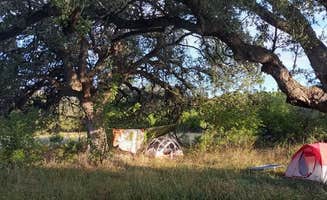Primitive camping near The Hills, Texas centers on the backcountry areas surrounding Lake Georgetown. The area sits at approximately 800 feet elevation within the Texas Hill Country, with limestone terrain creating both rocky exposures and scattered tree cover. During spring and fall, temperatures typically range from 50-85°F, while summer months regularly exceed 95°F with high humidity, making proper hydration essential for overnight campers.
What to do
Shoreline exploration: At Sawyer Park Primitive Campsites, visitors can set up camp near the lake after the hike in. "We ended up not following our AllTrails after a fork in the road heading towards the campsite, and were pretty pooped so decided to camp there off Sawyer Campsite Rd. People had clearly used the shore as a campsite before as there was a makeshift fire pit and some cleared areas for tents. Water and views were beautiful," reports camper Alexandra.
Canoe camping: Walnut Springs Primitive Campground accommodates water access camping. "There was a backpacking group, a group of people who canoed in, and ourselves. Large open area; fire pits, lamp hangers, picnic tables, trees closer the trail and grass sea areas closer to the water," notes Guillermo L., highlighting the multiple access options.
Trail section hiking: The full 26.2-mile loop can be broken into smaller segments for day hiking from dispersed camping spots. "The trail circles Lake Georgetown and passes through forests, grasslands, over some small hills and across a few tributaries," explains Troy W., noting the diverse terrain available to experience in smaller sections.
What campers like
Multiple access points: The dispersed camping areas offer various entry options. "Can be biked in from Camp Tejas four miles away or can hike in from Russell Park 2 miles away," explains Guillermo about Walnut Springs Primitive Campground, making it accessible to hikers with different experience levels.
Established fire rings: San Gabriel River Trail campsites often feature improvised but functional fire pits. "There are a few areas with tent pads or clear areas where you may camp. But there are also zones where you may simply camp wherever you can setup a tent or hammock," shares Troy W., describing the flexibility of site selection.
Weekday solitude: Primitive camping areas become notably quieter during weekdays. "The trail is getting more and more popular with backpackers, so it is likely that you may see others on the trail. On weekends you may encounter scout troops practicing backpacking. During the weekdays you may not see a single person," notes Troy W.
What you should know
Water filtration required: No potable water exists at any primitive sites. "Be prepared to dig cat hole, if drinking lake water be prepared to filter and sterilize," cautions Guillermo L. at Walnut Springs, emphasizing the need for proper water treatment equipment.
Weather vulnerability: Camping areas offer limited protection from storms. "Enjoyed our stay during a thunderstorm under the big trees," reports Guillermo L., suggesting that while some shelter exists, campers should prepare for direct exposure to weather events.
Limited shade coverage: Much of the trail system and camping areas lack significant tree cover. "I'd say that 40% of the trail has some tree coverage, but 60% is exposed," states Troy W., highlighting the need for sun protection during warmer months.
Tips for camping with families
Distance planning: Select campsites based on your family's hiking capacity. "The Sawyer Park site is only accessible by hiking or by a boat. It is about 5 miles from the Tejas Campground and 5 miles from Cedar Breaks Campground," explains Troy W., noting the substantial hiking distances required.
Rain preparation: Pack extra waterproofing materials for family tents. "Rain started pretty heavily (and being close to the water probably didn't help with humidity inside the tent) and our rain fly was unwilling to cooperate so we got a bit wet," shares Alexandra about her Sawyer Park experience.
Trail markers: Teach children to recognize trail markings to prevent getting lost at junctions. "We ended up not following our AllTrails after a fork in the road heading towards the campsite," notes Alexandra, demonstrating how navigation errors can occur even with digital aids.
Tips from RVers
Staging area parking: RVs can be used as base vehicles at designated parking areas while backpacking to primitive sites. "Upon entering one of the access points, park your car for free near the trailhead. It is good to advise one of the park attendants that you will be hiking or place a note inside your car that you are hiking," advises Troy W., suggesting proper communication with park staff regarding overnight parking.


